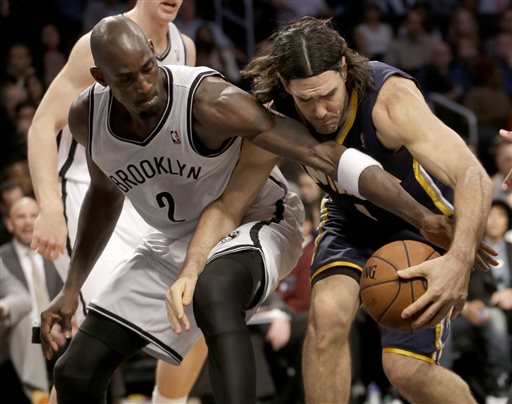
The Brooklyn Nets had to lose their best players to begin playing their best.
Weird, right? Nobody expected this stretch. The Nets just lost their youngest All-Star, Brook Lopez, for the season. Then Deron Williams went down, undergoing treatment on both of his ankles. They got dominated by a San Antonio Spurs team heading into the New Year. At 10-21, without a draft pick, all seemed lost.
Today, they stand at 15-22, in the playoff race. And while there are a lot of factors, they’ve got 37-year-old Kevin Garnett to thank most.
Garnett’s been vocal about his disdain for playing center, citing more comfort at the power forward position. He signed off on the trade to Brooklyn partially because he’d play next to Lopez, who would take his position in the paint. He played the majority of his first sixteen years at the power forward position, only playing spot minutes at center until playing it full-time his last two seasons in Boston. He, um, didn’t like it.
“Should’ve put that s— in my contract,” Garnett jokes about playing only at the 4. “Don’t tell Jason I said that.”
But with Lopez out, coach Kidd didn’t have much of a choice. Rookie Mason Plumlee is promising, but nowhere near a starting-caliber player yet. Andray Blatche is at the pinnacle of entertainment precisely because he’s at the nadir of reliability. Garnett was the natural choice, even if he doesn’t consider it his natural position.

we call them basketball players.”
– Jason Kidd (AP)
He takes to his newfound role like a moth to darkness. “It’s not my preference, but it is what it is, and whatever we have to do to win,” Garnett says of sliding over to the 5. “That’s what it is.”
Kidd’s done what he can to make the change more palatable. “There are no positions,” Kidd said when asked about Garnett’s change. “Just guard the guy in front of you. We don’t call him a five, we call them basketball players.”
But despite the positionless basketball mantra, the roles and responsibilities are quite clear. In a lineup filled by a point guard and three wing players, the towering Garnett, at 6’11”, 6’13”, or whatever height he is, mans the middle as the team’s procedural center.
And the difference has been staggering.

Brooklyn’s offense has hummed along just fine with or without Lopez and Williams, scoring 101.9 points per 100 possessions in 2013 and a nearly-identical 102.3 points per 100 possessions in 2014. But on defense, it’s an entirely new ballgame: the Nets have allowed just 99.8 points per 100 possessions in their first six games, which would rank them as a top-7 defense over a full season.
They’ve slowed down to a snail’s pace to accommodate their roster (they’ve played more than six fewer possessions per game), and it’s worked. They’ve worn down the defending champion Miami Heat, held a revolutionary run-and-chuck Golden State Warriors offense to 3-19 three-point shooting over the final 42 minutes, forced 21 turnovers out of Kevin Durant’s Oklahoma City Thunder, and held the third-seeded Atlanta Hawks to 38.6 percent shooting.
Nearly every Nets player has credited the team’s communication for their defensive improvement, and the talk starts with Garnett. That’s no secret: Garnett’s visible and vocal roaming the paint, something Lopez has worked on since his rookie year.
When the Nets are fully healthy, Lopez is the team’s best offensive player on a team that has four high-usage offensive-minded starters. Losing his offense is a potential killer, but they’ve got other high-level offensive players to manage the difference.
Defensively, Lopez is a better pure rim protector than Garnett these days when healthy, and his strength deterred numerous players in the post this season, but he’s not the quick help defender that Garnett is, even at 37 years old. At power forward, Garnett’s quickness is less important, since he’s often out of the paint and out of help position. But as a center, Garnett’s a one-man deterrent, leading to plays like this key block on Stephen Curry:
With Garnett on the floor since Lopez went down, the Nets have allowed just 47.9 percent shooting in the paint, and opponents have scored a full ten fewer points in the paint per 48 minutes with Garnett as the team’s designated center.
Note: League Average is as of 1/12/2014. Don’t see the chart? Refresh the page. Still don’t see it? Click here for the non-interactive image.
The NBA calls it smallball, but it’s more like longball. With the rangy Garnett and Shaun Livingston (6’7″ with a 6’11” wingspan) at point and center, the Nets have two extraordinary wingspans in their starting lineup. Add Paul Pierce (6’7″), Alan Anderson (6’6″ with a 6’10” wingspan), Joe Johnson (6’8″ with a 6’9″ wingspan), and Andrei Kirilenko (6’9″ with a 7’4″ wingspan), the Nets have a flurry of arms sneaking into passing lanes and blocking shots. (When Deron Williams returns to the lineup, expect him to play alongside Livingston and Anderson for equal stretches; the Livingston-Williams combo has exciting potential, but also leaves the Nets without a point guard off the bench.)
The return of Kirilenko, emergence of Livingston, and added defensive responsibilities for Garnett have turned the Nets into a strong defensive team. Since the beginning of 2014, they’ve forced more than two more turnovers per game, they’ve picked up four more points per game off turnovers, and have allowed nearly five fewer points per game in the paint.
Garnett deflects praise to his head coach, who has gone through his own hell this season between a fractured relationship with his former lead assistant, criticism from all angles, and a team decimated by health issues, and soda spills. “I think Jason has simplified some things, I think through the help of communicating and talking to one another, understanding those schemes and understanding what he wants. I feel like it’s helping us.”
“Then repetition, repetition. As easy as people may think it is to just come in and have one system then change another system up, it’s not that easy. Especially when you’re trying to create chemistry and create a type of flow.”
This isn’t a call to trade Brook Lopez, who is still the team’s best player. In the long-term, he’s their most viable star. Garnett’s legs will give at some point, and Pierce, a free agent after this year, will leave an offensive hole that the Nets will need Lopez to fill.
But in the short term this season, the Nets have had the chemistry they needed without Lopez. And all it took was moving their power forward to center, which was only possible by losing their best player.


















